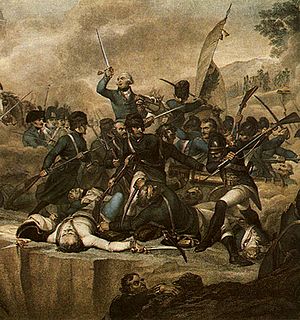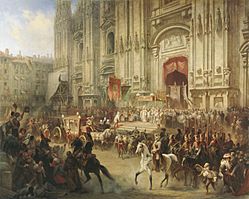Battle of Cassano (1799) facts for kids
Quick facts for kids Forcing of the Adda (1799) |
|||||||||
|---|---|---|---|---|---|---|---|---|---|
| Part of the Italian campaigns in the War of the Second Coalition | |||||||||
 Feldmarshal Suvorov at the battle of the Adda River on April 27, 1799 (painted by Luigi Schiavonetti) |
|||||||||
|
|||||||||
| Belligerents | |||||||||
|
|||||||||
| Commanders and leaders | |||||||||
| Strength | |||||||||
| Around 48,000–49,000 soldiers | Around 27,000–28,000 soldiers | ||||||||
| Casualties and losses | |||||||||
| 2,000–2,500 killed and wounded | 6,900–7,500 killed, wounded and captured 27 guns and 3 standards |
||||||||
The Battle of Cassano was a major fight that happened in 1799 near Cassano d'Adda, a town about 28 km (17 mi) east-northeast of Milan. This battle was part of a bigger conflict called the Battle of the Adda River, or the forcing of the Adda.
The fighting began on April 26, 1799, with a smaller win for the Russians at Lecco. The Russian forces were led by Alexander Suvorov. They fought against the French army, which was first commanded by Barthélemy Schérer.
On April 27, Suvorov's combined forces, including Austrians and Cossacks, defeated the French army. By this time, Jean Moreau had taken over as the French commander. The battle ended with a part of the French army being surrounded on April 28. This important event took place during the War of the Second Coalition, which was part of the larger French Revolutionary Wars.
The Battle of the Adda River actually involved four separate fights. The clash at Lecco was a Russian victory, but it didn't decide the whole battle. The most important fighting on April 27 happened at Vaprio d'Adda, north of Cassano. On the same day, at Cassano itself, the Austrians successfully attacked French defenses. This forced Moreau's army to retreat. A French group cut off at Vaprio was later surrounded at Verderio by Austrian forces under Josef Philipp Vukassovich.
Contents
Why the Battle Happened
While Napoleon Bonaparte was fighting in Egypt, a group of countries called the Second Coalition decided to invade French-controlled Italy. The French general Barthélemy Louis Joseph Schérer had already fought some battles against the Austrians in March 1799, but without clear winners.
Then, on April 4, the Austrians, led by General Pál Kray, defeated Schérer at the Battle of Magnano. This loss made the French army retreat a long way. Schérer tried to defend along the Mincio and Oglio rivers, but an Austrian force led by Josef Philipp Vukassovich outflanked him (went around his side). Soon after, Russia's allies, led by General Suvorov, arrived to join the fight.
Suvorov quickly took the fortress of Brescia without a fight. His Cossack troops captured Bergamo, and his advance guard pushed back French outposts. When Field Marshal Suvorov joined the allied army, he took overall command. He and the Austrian general Michael von Melas then chased the French army.
Who Fought in the Battle
The French Army's Strength
General Schérer placed his divisions, led by Generals Paul Grenier, Claude Victor, and Jean-Mathieu-Philibert Sérurier, to defend the Adda River line. Each of these divisions had about 8,000 soldiers. Another division, led by Pierre de Laboissière, had about 4,000 men. Victor's and Grenier's divisions also included soldiers from Poland and Switzerland.
The Coalition Army's Strength
The Russian advance guard was led by Pyotr Bagration with 3,000 men. The main Russian force was led by Andrei Rosenberg with 9,000 men. The Austrian army made up most of the allied forces, with about 30,000 Austrians and 20,000 Russians under Suvorov's command. There were also about 1,500 irregular Cossack cavalry.
The main Austrian division commanders were Peter Ott, Johann Zopf, Franz de Lusignan, Konrad Valentin von Kaim, and Josef Philipp Vukassovich. General Michael von Melas was sent to Cassano and was the overall commander of the Austrian forces under Suvorov.
The Battle Unfolds
The Adda River was a strong natural defense because it was wide and deep, with steep banks. However, General Schérer spread his 28,000 soldiers too thinly over 100 km (62 mi) along the river. This meant no single spot had enough defenders. Suvorov sent some troops to create distractions and then focused his main force of 35,000 to 36,000 men on the main French line.
The battle was fought in three main parts:
- The fight at Lecco, where Suvorov sent the Russians, likely as a distraction.
- The battles near Trezzo sull'Adda and Vaprio d'Adda, where mostly Austrians fought. These battles were key to the allied victory.
- The fight around the fortified position of Cassano, where Melas's Austrians were sent. They would eventually get behind the French.
Fighting at Lecco
On the night of April 26, Prince Bagration reported that Lecco was strongly held by the French. Suvorov sent Bagration's troops, including jaegers and Cossacks, to attack Lecco.
At 8 AM, Bagration's forces met a small French unit outside Lecco, pushed them back, and approached the city. The city was defended by four French battalions and one cavalry squadron. The Cossacks surrounded the city. The Russians attacked in three columns and broke into the city. The French fought back hard, pushing the Russians out.
The French then tried to go around the Russian forces. Russian reinforcements arrived, stopping the French flanking move. The city was taken back by the Russians. The battle lasted 12 hours. The Russians lost 385 men killed or wounded, and Bagration was among the wounded. The French left 100 prisoners.
Meanwhile, Vukassovich approached Brivio, which was lightly defended, and began to prepare a crossing. The Russians then moved away from Lecco to settle for the night. In total, about 4,993 Russians and 5,000 French fought at Lecco. The French eventually retreated from Lecco during the night of April 27-28, realizing the Allies had crossed the Adda elsewhere.
Battles at Vaprio & Cassano
On April 27, General Schérer, who was struggling, handed over command of the French army to the more skilled General Moreau. Suvorov was pleased, saying it would be a greater honor to defeat Moreau.
At midnight on April 27, Austrian General Ott began building a pontoon bridge at Trezzo. This spot was difficult for a bridge, but the French had not guarded it well. The work was done silently, and by daybreak, the bridge was ready. French soldiers only noticed their mistake in the morning, but it was too late. Austrian and Cossack troops quickly crossed the river.
Suvorov himself was at Vaprio, urging his troops to cross. He gathered about 20,000 soldiers there, while Moreau had 15,000. Moreau believed this was the main attack. He rode to the battlefield and almost ran into Cossacks. General Grenier was ordered to take a position between Vaprio and Pozzo d'Adda.
Grenier's brigade stopped Ott's advance. The French held a strong defensive position in the village of Vaprio, which was good for infantry. The area had many vineyards and stone walls that acted like natural defenses. When more French troops arrived, they had a numerical advantage and began to push back Ott's division.
However, Denisov's Cossacks and Austrian hussars charged from the French left side, stopping their attack. They broke into the French infantry ranks, forcing them to retreat. The Cossacks also attacked French cavalry, chasing them and capturing many prisoners.
Ott and Zopf's divisions broke through the French lines. With more Austrian battalions arriving, the Austrian infantry attacked the villages of Pozzo and Vaprio. Suvorov encouraged his tired soldiers. After fierce fighting, both villages were captured. At this point, about 11,000 Austrians and Cossacks faced 7,000 French.
Moreau, seeing that his reinforcements were not arriving and hearing fighting from Cassano, ordered Grenier to retreat. But it was too late. The French defenses in front of Cassano were under heavy pressure. The French held their position for five hours behind a canal.
Suvorov ordered General Melas to take Cassano at any cost. The Austrians used 30 guns, built a bridge, and stormed the French fortifications so quickly that the French couldn't destroy the bridge or remove their guns as they retreated. The Austrian troops crossed the bridge, getting behind the French retreating from Vaprio. This cut off the direct road to Milan, forcing the French to retreat in different directions.
After continuous hard fighting from 6 AM to 6 PM, the allied forces were too tired to pursue the French further. The Cossacks followed the retreating French. The Allies captured 19 guns, a battle flag, and over 2,000 prisoners. The French suffered many killed and wounded. The Allies lost over 1,000 men. Suvorov praised the bravery of the Don Cossacks. By the evening of April 27, the battle was decided, and the way to Milan was open.
At the same time, Vukassovich defeated a small French outpost at Brivio and crossed to the right bank of the Adda. The French barely managed to retreat to Lake Como.
The Fight at Verderio
General Sérurier, following Moreau's orders, stopped between Verderio and Paderno d'Adda. He dug in carefully and waited for orders through April 27 and the night of April 28. He was cut off by Ott from the south and Vukassovich from the north. The main battle was over, and Moreau had retreated, but Sérurier's force remained unnoticed.
Early on April 28, an Austrian advance group and Cossacks met a French cavalry post. The Cossacks pushed them back and unexpectedly found a whole French force. Vukassovich, seeing they were surrounded, asked them to surrender. When they refused, he attacked. The Austrians and Cossacks drove the French out of Paderno. Vukassovich then went around Verderio and attacked the French from behind.
The French fought hard at Verderio, even trying to attack the enemy's side. But when Rosenberg's main Russian troops (about 17,000 allied soldiers) arrived, Sérurier realized further resistance was useless and surrendered. Vukassovich captured 3,000 French soldiers at Verderio.
What Happened After the Battle
Soon after their victory, Suvorov famously wrote that the Adda River was like the "Rubicon," and they had crossed it over the bodies of their enemies.

In the battles at Lecco, Vaprio, Cassano, and Verderio, the French used between 18,000 and 18,500 soldiers. They lost about 2,500 killed and wounded, plus 5,000 soldiers captured, along with 27 cannons and 3 battle flags. At Verderio alone, the French lost 300 killed and wounded, and 2,700 captured. The Austro-Russians lost between 2,000 and 2,500 killed and wounded. Some sources estimate higher losses for both sides.
Moreau retreated, leaving a small group of 2,400 soldiers in Milan's fortress. His divisions pulled back to different towns. The Austrians continued their advance, capturing Turin on June 20. Milan's fortress surrendered on May 24. The most important result of this battle was that the Cisalpine Republic, which France had created, was now back under the control of the Habsburg monarchy.
The next major battle for the Allied army was the Battle of Bassignana on May 12, which they lost. However, Suvorov's forces quickly fought back at the First Battle of Marengo just four days later. The next big fight was the Battle of the Trebbia in June.
See also



